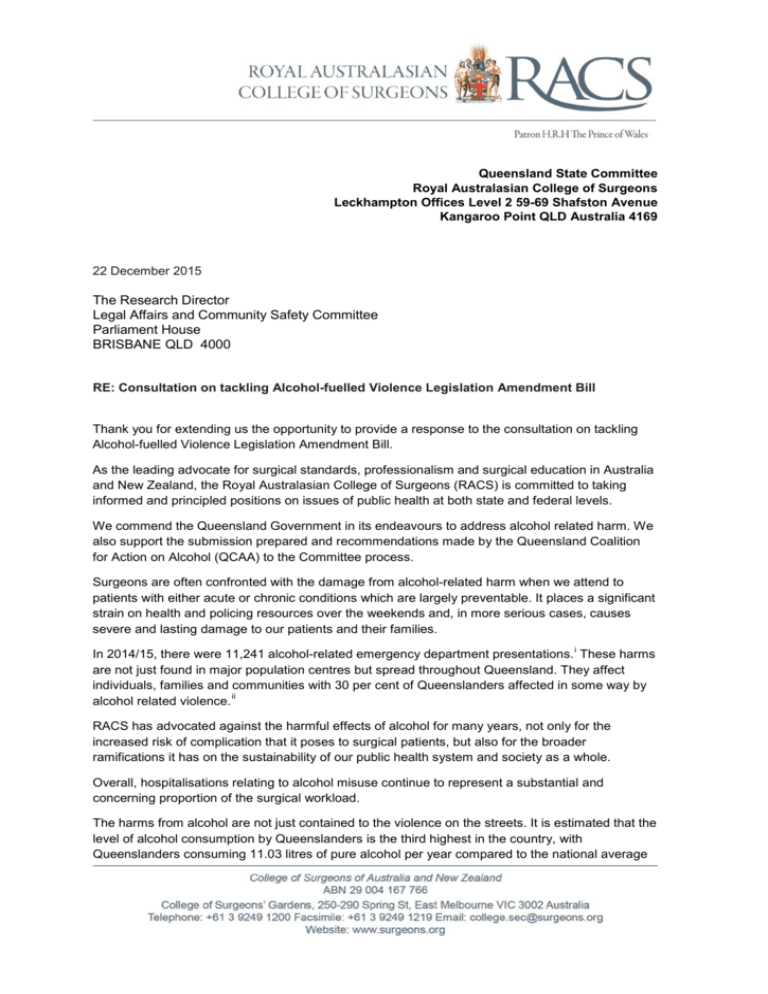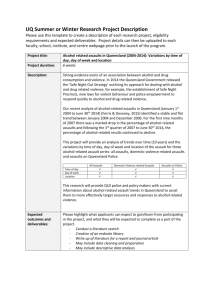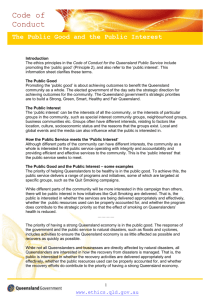LTR 2015-12-14 Qld Reg Comm Alcohol-related Harm SBM
advertisement

Queensland State Committee Royal Australasian College of Surgeons Leckhampton Offices Level 2 59-69 Shafston Avenue Kangaroo Point QLD Australia 4169 22 December 2015 The Research Director Legal Affairs and Community Safety Committee Parliament House BRISBANE QLD 4000 RE: Consultation on tackling Alcohol-fuelled Violence Legislation Amendment Bill Thank you for extending us the opportunity to provide a response to the consultation on tackling Alcohol-fuelled Violence Legislation Amendment Bill. As the leading advocate for surgical standards, professionalism and surgical education in Australia and New Zealand, the Royal Australasian College of Surgeons (RACS) is committed to taking informed and principled positions on issues of public health at both state and federal levels. We commend the Queensland Government in its endeavours to address alcohol related harm. We also support the submission prepared and recommendations made by the Queensland Coalition for Action on Alcohol (QCAA) to the Committee process. Surgeons are often confronted with the damage from alcohol-related harm when we attend to patients with either acute or chronic conditions which are largely preventable. It places a significant strain on health and policing resources over the weekends and, in more serious cases, causes severe and lasting damage to our patients and their families. i In 2014/15, there were 11,241 alcohol-related emergency department presentations. These harms are not just found in major population centres but spread throughout Queensland. They affect individuals, families and communities with 30 per cent of Queenslanders affected in some way by ii alcohol related violence. RACS has advocated against the harmful effects of alcohol for many years, not only for the increased risk of complication that it poses to surgical patients, but also for the broader ramifications it has on the sustainability of our public health system and society as a whole. Overall, hospitalisations relating to alcohol misuse continue to represent a substantial and concerning proportion of the surgical workload. The harms from alcohol are not just contained to the violence on the streets. It is estimated that the level of alcohol consumption by Queenslanders is the third highest in the country, with Queenslanders consuming 11.03 litres of pure alcohol per year compared to the national average iii of 10.42 litres. This has implications for long term health since alcohol is associated with more 1 than 200 health conditions such as different types of cancer , cardiovascular disease, liver iv cirrhosis and pancreatitis. In Queensland, there were 1,143 alcohol-related deaths in 2010 and 32,844 alcohol-related hospitalisations in 2010/11. By 2014/15, alcohol-related hospitalisations had v reached 45,197, an increase of 38 per cent. At alcohol and other drug treatment services, alcohol vi was the principal drug of concern in 37 per cent of episodes of care. The Amendment Bill recognises that action needs to be taken to reduce the harm from alcohol in Queensland. Queenslanders understand the need for action with 74 per cent of Queenslanders believing that Australia has a problem with alcohol and 71 per cent believing that more needs to be vii done to reduce alcohol-related harms. Specifically, Queenslanders support earlier closing hours and lockouts, also known as a one-way door, with 82 per cent of Queenslanders supporting a closing time for pubs, clubs and bars of no later than 3am and 61 per cent supporting a 1am viii lockout. The measures introduced in the Amendment Bill for on-licence premises, such as pubs, clubs and bars are welcomed and appropriate. In particular, the 2am last drinks measure to be implemented state-wide, unless the venue is in a prescribed 3am safe night precinct (in which case it can apply to trade until 3am last drinks in conjunction with a 1am one-way door), provides a strong message that the Queensland Government is serious about introducing meaningful measures that will be effective in reducing alcohol harm. Late night trading hours are the hours when patrons are most at risk of alcohol harm. Australian and international research demonstrates that for every additional hour of trading, there is a 16-20 per cent increase in assaults and that conversely, for every hour of reduced trading there is a 20 ix,x per cent reduction in assaults. Research has also shown that alcohol-related assaults increase xi,xii significantly after midnight. The success of these types of measures is well known in Australia. Newcastle saw a 37 per cent reduction in night time assaults between the hours of 10pm and 6am, 18 months after it introduced xiii earlier closing hours in conjunction with a lockout (3.30am close; 1.30am lockout). Five years later, the reduction in alcohol-related assaults remained with an average 21 per cent reduction in xiv assaults per hour observed. More recently in Sydney, non-domestic assaults have decreased by 32 per cent in Kings Cross and 26 per cent in the Sydney Central Business District (CBD) following xv the introduction of 3am last drinks and 1.30am lockouts in February 2014. In one area of the xvi Sydney CBD, the reduction in non-domestic assaults was as high as 40 per cent. As the above examples demonstrate, earlier closing hours have been proven to be effective in reducing alcohol harms. The Government should feel confident that it is introducing the right measures to achieve its objectives of reducing alcohol-related violence. The alcohol industry argues that earlier closing times and the one-way door will shut down Queensland’s night life and that tourist numbers will decline. However, it appears that the contrary is likely to occur. A study by the Australian National Local Government Drug and Alcohol Advisory Committee found that between 2009 and 2011 there was a 9.6 per cent decline in ‘drink’ sales 1 For example, 30 per cent of deaths and 42 per cent of hospitalisations associated with oral and pharynx cancer in men and 54 per cent of deaths and 65 per cent of hospitalisations associated with breast cancer in women revenue in Newcastle following the restrictions, which was offset by a 10.3 per cent increase in xvii ‘food’ sales revenue. While welcoming the above measures, RACS is concerned about the exemptions that apply to this Amendment Bill regarding the 10pm close for packaged liquor. Exemptions will weaken the effectiveness of the measures and therefore should be avoided. Forty-three per cent of packaged xviii liquor outlets trade between 10pm and 12am , which means that the alcohol harm arising from packaged liquor outlets will continue. This exemption is surprising in light of the association xix between packaged liquor outlets and family violence and the commitment of the government to reduce family violence in Queensland. RACS strongly recommends that the provision for a 10pm close applies to all packaged liquor outlets with no exceptions and that venues currently trading after 10pm be required to wind back their trading hours to 10pm from 1 July 2016. RACS recommends that the Government introduces a moratorium on late night trading to limit the risk of harm while it develops a framework to manage assessment of applications for new liquor licenses or to extend trading hours. In 2014, the Newman Government removed the moratorium on late night trading when it introduced its Safe Night Out Strategy. This action saw a flurry of applications with more than 120 new approvals for late night trading hours approved in the 12 xx months to September 2015. These approvals have resulted in a significant increase in the number of late night trading hours each night as new venues trade after midnight and existing late night venues extend their trading hours. Since late night trading hours are associated with increased levels of harm, it is important to minimise the risk of harm while the framework is being developed. On behalf of the Royal Australasian College of Surgeons, we again thank you for extending us with the opportunity to provide comment on this important area of public policy. Yours Sincerely, Owen Ung Chair, Queensland State Committee Richard Lewandowski Chair, Queensland Trauma Committee i Queensland Health (2015) Alcohol-related presentations Emergency Department statistics 2007-2015 provided to FARE by QLD Health Foundation for Alcohol Research and Education (2015) Annual Alcohol Poll 2015 Canberra: FARE iii Gao C, Ogeil RP & Lloyd B (2014) Alcohol’s burden of disease in Australia Canberra: FARE and VicHealth in collaboration with Turning Point iv Gao C, Ogeil RP & Lloyd B (2014) Alcohol’s burden of disease in Australia Canberra: FARE and VicHealth in collaboration with Turning Point v Queensland Health (2015) Admitted patient episodes of care for diagnosis of 'Alcohol related conditions', Public and Private acute hospitals, Queensland 2002/2003 to 2014/2015 Data provided to FARE by QLD Health vi Australian Institute of Health and Welfare (2015) Alcohol and other drug treatment services in Australia 2013–14: state and territory summaries viewed on 8 December 2015 at http://www.aihw.gov.au/publication-detail/?id=60129551120 vii ibid viii ibid ix Kypri K, Jones C, McElduff P, Barker DJ. (2010. Effects of restricting pub closing times on night-time assaults in an Australian city', Addiction, 106 303-310 x Rossow, I & Norström, T (2011) The impact of small changes in bar closing hours on violence. The Norwegian experience from 18 cities Addiction Vol 107, Issue 3. xi Jochelson, R (1997). Crime and Place: An analysis of assaults and robberies in Inner Sydney Sydney: New South Wales Bureau of Crime Statistics and Research xii Briscoe, S. & Donnelly, N (2001) Temporal and regional aspects of alcohol-related violence and disorder Alcohol Studies Bulletin xiii Kypri K, Jones C, McElduff P, Barker DJ. (2010. Effects of restricting pub closing times on night-time assaults in an Australian city', Addiction, 106 303-310 xiv Kypri, K, McElduff, P & Miller, P (2014) Restrictions in pub closing times and lockouts in Newcastle, Australia five years on Drug and Alcohol Review 33, 323–326 xv Menéndez P, Weatherburn D, Kypri K & Fitzgerald J (2015) Lockouts and last drinks: The impact of the January 2014 liquor licence reforms on assaults in NSW, Australia Crime and Justice Bulletin: Contemporary Issues in Crime and Justice Number 183 xvi Menéndez P, Weatherburn D, Kypri K & Fitzgerald J (2015) Lockouts and last drinks: The impact of the January 2014 liquor licence reforms on assaults in NSW, Australia Crime and Justice Bulletin: Contemporary Issues in Crime and Justice Number 183 xvii Bevan, T (2013). The Australian Night Time Economy A First Analysis 2009 to 2011. Canberra: The National Local Government Drug and Alcohol Advisory Committee. xviii Office of Liquor Gaming and Regulation (2015) Queensland Liquor Licences issued at 31 October 2015 Data provided to FARE by OLGR xix Livingston M (2011) A longitudinal analysis of alcohol outlet density and domestic violence Addiction, 106, 919-925 xx Personal communication to FARE, September 2015 ii





